BETA’S 2025 MODEL RANGES: YOUR FAQS ANSWERED
After testing Beta’s smorgasbord of 2025-model machines at the recent Australian media launch in Queensland, we can now answer your most frequently asked questions about them. Let’s go…
You can’t accuse Beta of short-changing consumers when it comes to choice. Just do the math on their model line-up for 2025. In addition to their two MX machines, the RX450 and RX300, Beta also offers the unique Xtrainer 250 and 300, an eight-model RR X-Pro range, and an eight-model RR Race range. That’s 20 different models, covering everything from a 125cc two-stroke to a 480cc four-stroke (and that tally doesn’t include Beta’s Trial bikes, or their swag of smaller-capacity Enduro and Motard models that are available in other markets around the world!). So, in many ways, a Beta dealership’s biggest challenge is to help their customers figure out which model (and capacity) is best suited to their ability and the sort of riding they primarily do.

As has become their annual habit, Beta has been busy with upgrades to their 2025 models. In fact, you could argue the Italian manufacturer has collectively brought more upgrades to more models than any other off-road motorcycle manufacturer this year. But which of Beta’s model-ranges receives the most significant upgrades for 2025? Is the line-up of models in each range now more clearly delineated from one another? What sort of rider has each model-range been designed for? And how do the price tags on these 2025 Betas compare with each other, and with rival brands on the market?
Yep, Beta’s veritable smorgasbord of models always prompts a bunch of questions. And seeing as we’ve been fielding a lot of questions in the wake of the recent Aussie media launch for Beta’s 2025 model range, we figured it was time to cough up some answers – to your most frequently asked questions, anyway. Here goes…
WERE THE BIKES AT THE MEDIA LAUNCH IN STANDARD TRIM?
Yes … aside from the fitment of accessory handguards to the RR X-Pro models and Pirelli tyres across the board (all bikes at the launch were tested with Pirelli rubber, as Beta Motorcycles Australia has an arrangement with Pirelli’s distributors in Oz). For the record, the standard tyres that come on Beta’s model-ranges are:
- 2025 RX models – Michelin Starcross 6
- 2025 Xtrainer – Mitas Terra Force-EF
- 2025 RR X-Pro models – Maxxis MaxEnduro
- 2025 RR Race models – Maxxis MaxEnduro
Some journos pointed out that the aggressive Pirelli hoops meant that the launch bikes’ performance would not be representative of how they come off dealer floors. Which is true. But on the other hand, having the same Pirellis fitted across the entire range made it easier to compare bikes from one model-range with their capacity counterpart in another. In other words, running the same tyres removed the grip and feel variable, which allowed us to focus on core differences in performance.

OF ALL BETA’S 2025 MODELS, WHICH STAND OUT AS THE MOST SIGNIFICANTLY UPDATED?
The eight-strong RR X-Pro range gets the most notable updates for 2025 because these models are much more than just a rebranded version of their 2024 (“RR”) predecessors. The 2025 RR X-Pro machines – which come with a major frame and suspension updates (including an all-new split-function ZF SHC fork), Xtrig Flexfit handlebar mounts, all-new bodywork, a 20mm lower seat height, revised rear brake master cylinder, a grab-handle for extreme terrain, and a bunch of other tweaks – are designed to cater to a wider cross-section of riders and terrain. And, according to Beta, the new RR X-Pro models are better positioned as a middle-ground between their Xtrainer and RR Race ranges. That’s not to say the other models were overlooked on the upgrade front for 2025 (though the 2025 Xtrainers only really get a fresh look with distinctive-looking grey plastics). The 2025 RX (motocross) and 2025 RR Race (up-specced enduro) also copped their fair share of upgrades; once again, underlining Beta’s willingness to constantly bring upgrades to each year-model, rather than every three years, as other manufacturers tend to do.

OKAY, BUT REMIND ME ABOUT THE HEADLINE MODS THAT APPEARED ON THE 2025 RX & RR RACE MODELS?
Staying very topline here, the 2025 RX300 and RX450 both get new engine mapping, rear axle, footpegs and Xtrig FlexFit bar mounts. But a majority of the update attention was heaped on the RX300 for 2025 – its frame, subframe, engine, transmission, fork, shock, brakes and radiators – to ensure it completed the journey from an enduro-derived MX machine to a fully-fledged five-speed motocross weapon (as Beta’s RX450 has been from the get-go.) Meanwhile, the 2025 RR Race models get all-new bodywork, a new Nissin front brake calliper, larger (22mm) rear axle and redesigned footpegs. Plus, the four-stroke RR Race models all receive new, lighter crankcases (derived from the RX450 MXer); the RR250 Race gets a new cylinder head with dual spark plug (adopting what was introduced to the RR300 Race in 2024); and the RR125 Race boasts an all-new powerplant!

DID BETA ACHIEVE THEIR STATED GOAL OF MAKING EACH OF THE ENDURO MODEL-RANGES MORE DISTINCT FROM ONE ANOTHER?
Yep. For us, that’s one of the standout achievements of Beta’s line-up of 2025 machines. And we’re not just talking here about the progression of power character from seamlessly smooth (Xtrainer models) to broad and user-friendly (RR X-Pro models) to race-ready and responsive (RR Race models). It’s bigger-picture than that. The Xtrainer, while only getting (grey) plastic surgery for 2025, now looks distinctly different from both the red-and-white RR X-Pro and red-white-and-blue RR Race bikes. Meanwhile, the collective upgrades to the all-new RR X-Pro bikes helps the range create its own ‘identity’ and appeal to a wider cross-section of riders, rather than being simply considered as a ‘standard’ or down-specced version of an RR Race model. The differences between 2025 Xtrainer, RR X-Pro and RR Race models are also reinforced by the respective differences in suspension componentry (Olle R16V, Sachs ZF and Kayaba), and the 910mm, 930mm and 950mm seat heights they come with, respectively.

WITH BETA’S ENDURO MODELS, WHICH ARE THE BIGGEST SELLERS?
The Xtrainer 300 is Beta’s biggest-selling model (in Australia and several other markets around the world) and has been for some time – a fact that Beta would rather the media kept quiet in case it encourages other manufacturers to produce something similar and rain on their parade. After the chart-topping Xtrainer 300, the RR300 and RR300 Race have been the next biggest sellers, followed by the RR390 four-stroke.
WHAT’S THE RATIO OF SALES BETWEEN THE RR X-PRO & RR RACE MODELS?
About a year ago, when we asked the guys at Beta Australia about the relative sales of their 2024 ‘standard’ and ‘up-specced’ enduro models, they told us that the ratio was about 60/40. Interestingly, though, that’s changed significantly over the past 12 months, with the RR Race models overtaking their less fancy counterparts. The sales ratio between the model-ranges is now more like 50/50 or even 40/60, depending on the model.

HOW DOES BETA DEFINE & DIFFERENTIATE THE TYPE OF RIDER THAT THEIR XTRAINER, RR X-PRO & RR RACE MODELS ARE EACH DESIGNED FOR?
Beta has evidently put a lot of thought into this, so let’s go straight to the source and quote from their Powerpoint presentation about “matching the customer with the bike”:
- Xtrainer models: Ideal first enduro bike. Perfect for tight trail/bush riding. Older rider looking for something lighter. Suited to smaller and/or female riders, or experienced riders looking for a light, fun bike.
- RR X-Pro models: 70% of all riders. Great all-rounder for those who ride a mix of singletrail, faster tracks and technical terrain. Experienced enduro riders who ride for fun, but don’t push hard or race.
- RR Race models: Experienced enduro riders who push and/or race (AORC, state-level, Transmoto events, etc). Might ride occasional MX track, hitting jumps. Can be too firm or harsh for inexperienced, slower riders.

ARE THE PRICE RELATIVITIES BETWEEN BETA’S MODELS RIGHT?
Beta has always been aggressive with their pricing in the Australian market (and that sharp price philosophy extends to their spare parts too). The $1800-$2000 differential between Xtrainer and RR X-Pro models makes perfect sense – given each range’s component spec and performance capabilities. But we can’t help thinking that the $1200-$2000 price premium the up-specced 2025 RR Race models carry over their ‘standard’ RR X-Pro counterparts could be larger. Let us clarify what we mean here because far be it for us to suggest manufacturers increase their bikes’ price tags. We’re just saying that consumers are likely to feel that even $2000 seems a more-than-reasonable premium to pay to get the RR Race models’ gold-standard Kayaba fork and shock (not to mention the host of other upgrades and trick components the red-white-and-blue machines come with). We suspect that’s not only why sales for the up-speeced RR Race models have overtaken the ‘standard’ enduro models in the past year, but also why a lot of riders who should have bought an RR X-Pro model ended up buying an RR Race instead.

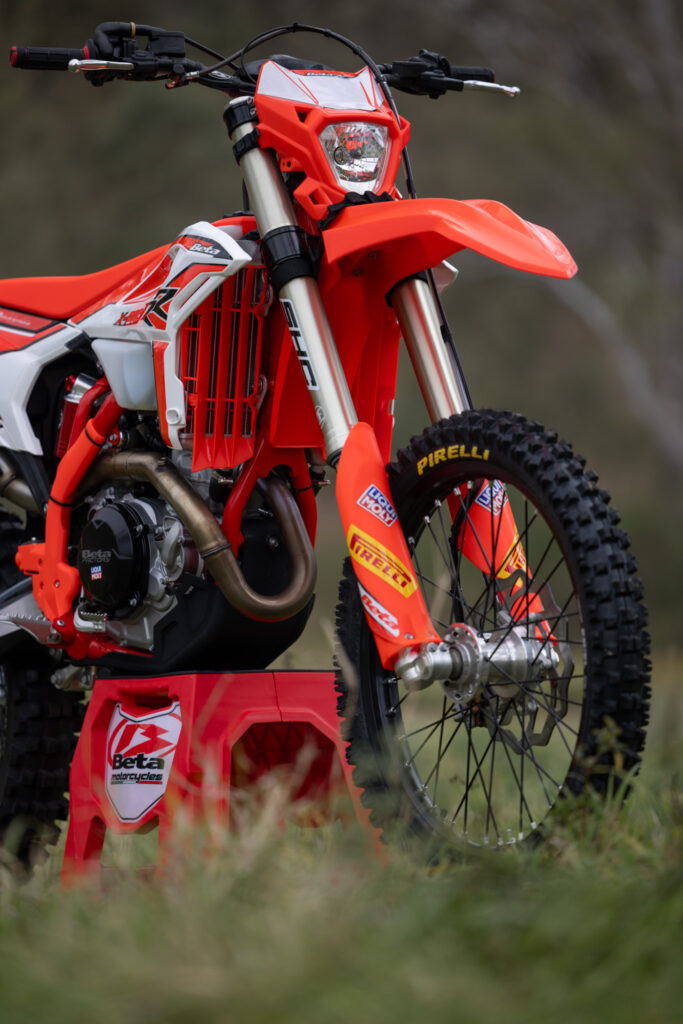
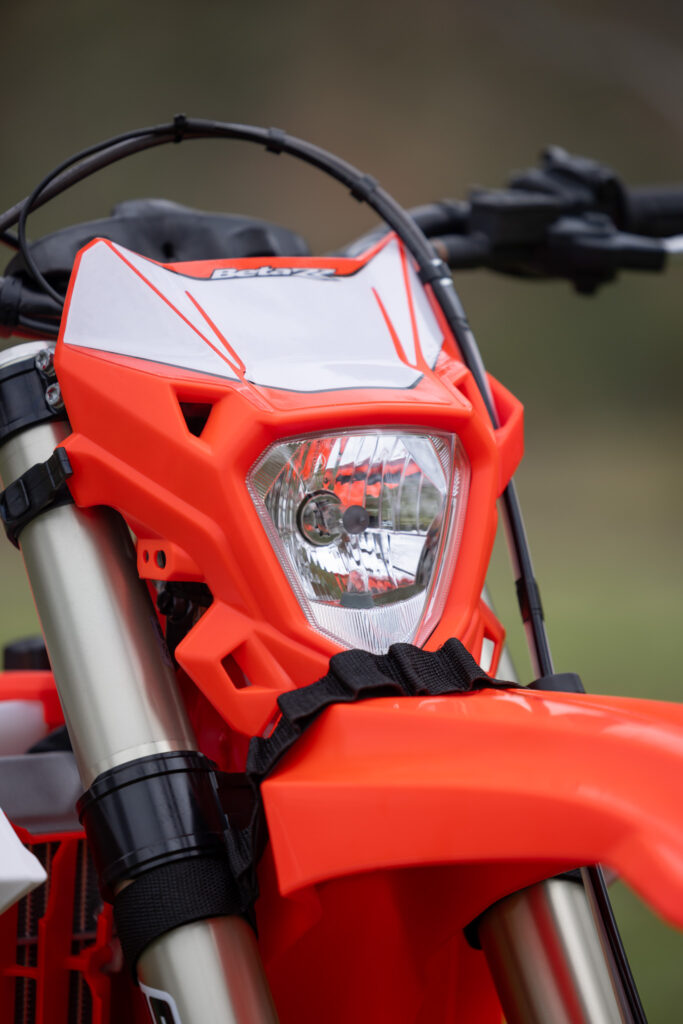
HOW DO THE SUSPENSION SETTINGS DIFFER FROM ONE MODEL TO THE NEXT?
In an era when motorcycle manufacturers are increasingly focused on cost-efficiencies through component standardisation, you could forgive Beta for using the same suspension settings across several, or all, models in a particular range. But instead, and to their credit, they’ve customised the settings – the fork and shock spring rates, valving specs and oil volume – for various models in each 2025 range. That underlines the effort Beta has gone to with these machines to optimise each model’s handling character. Stay tuned for a following article in which we’ll detail these differences in suspension settings.
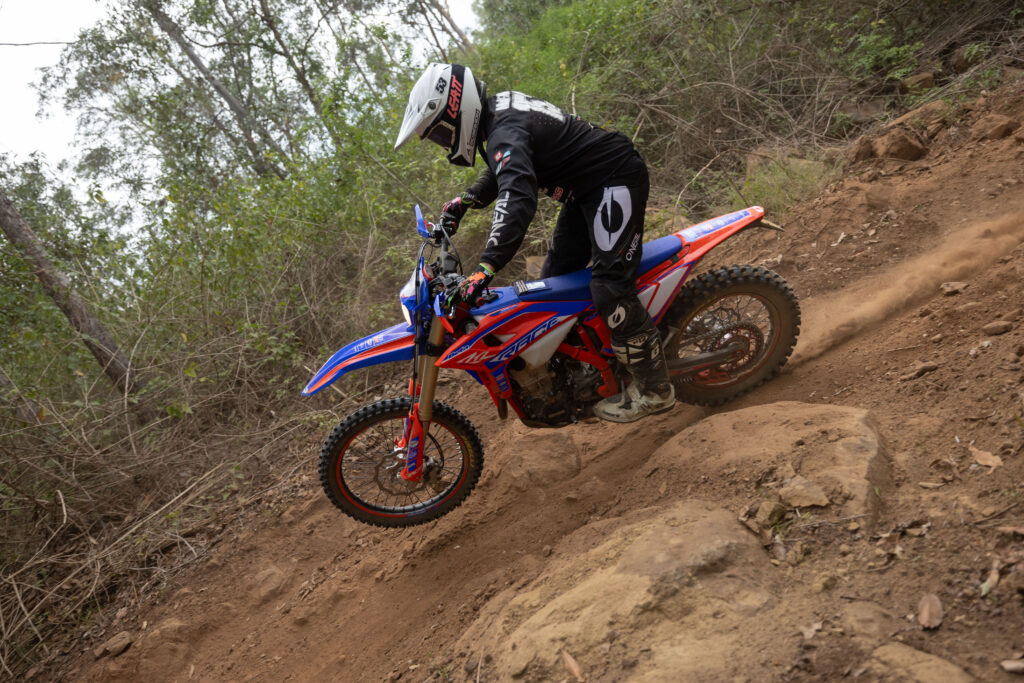
HOW DO THE 2025 RR X-PRO BIKES HANDLE RELATIVE TO THEIR 2024 RR PREDECESSORS?
The combination of a stiffer frame (torsionally and laterally), new ZF SHC (Separate Hydraulic Chamber) fork, and significantly revised ZF shock absorber gives the 2025 RR X-Pro models more of a sure-footed, planted feel than their predecessors on technical trails and tracks, especially at lower speeds (the new Xtrig polymer-damped handlebar mounts probably contribute to this complaint ride too). And that translates into excellent traction at both ends on hardpack, when grip is hard to come by. Meanwhile, the 20mm lower (930mm) seat height (achieved by ‘de-stroking’ the ZF suspension at both ends) helps give the 2025 chassis noticeably more side-to-side agility and quicker response to steering inputs – which, again, is a real bonus on tight trails. Even on decent-sized, square-edged bumps at speed, the 2025 rolling chassis remains composed and predictable under acceleration, while the improved oil flow in the 2025 shock noticeably helps the rear-end process bigger hits and downhill braking bumps without being knocked off-line. But perhaps the most impressive aspect of this new suspension package is that it creates a better front-to-rear chassis balance (addressing criticisms the 2024 chassis was too nose-down). When pushed hard by a heavier and/or faster rider, however, this plush and compliant suspension package does find its limits, much like its predecessors did – except that when the 2025 fork and shock bottoms out, they do so with more of a controlled bump against the stops (as opposed to the 2024 bikes’ arm-slamming hard metallic clunk). When you consider Beta explicitly says the 2025 RR X-Pro models are designed for “enduro riders who ride a mix of terrain for fun, but don’t push hard or race”, this shouldn’t come as a surprise.

WHEN IT COMES TO HANDLING IN GENERAL, HOW BIG A DIFFERENCE IS THERE BETWEEN THE RR X-PRO & RR RACE MODELS?
It’s hard to answer this one with too much conviction because we didn’t test all eight 2025 RR Race models at the launch (Beta Australia managed to air-freight only a 2025 RR300 Race and RR350 Race) against their RR X-Pro counterparts. But we can still draw some conclusions from our back-to-back testing…
If you sit on the equivalent model in each range – let’s take the RR300 X-Pro and RR300 Race as an example – with your eyes shut, the only noticeable difference is the slightly taller seat height on the Race machine, and the fact its suspension feels firmer at both ends, even when you hold the front brake and rock it back and forth. But as soon as you get moving, you notice the two bikes feel vastly different. Despite both machines’ bodywork and ergos being identical (in dimensions, anyway), the Race model sits much higher in it stroke, and uses a lot less suspension travel for any given bump. Where the RR Race models’ Kayaba suspension really comes into its own is bigger hits – such as high-speed G-outs or flat landings when you huck it a little too enthusiastically off an erosion mound. As we’ve come to expect, the MX-derived Kayaba (closed-cartridge, AOS-type) fork and shock delivers an incredibly progressive action at both ends; soaking up small bumps effortlessly, but then giving you a whole lot more bottoming resistance when you slam something hard. That said, the Kayaba suspension only rewards a rider who’s heavy or quick enough to push it hard. A soon as you revert to sit-down, passive trailrider mode, the firmer Kayaba suspenders will dish out a beating to your hands and arse, and accelerate any fatigue that’s already set in. Plus, the Race model’s taller seat height means it requires a bit more manhandling to change direction in tight terrain.




WHICH SUSPENSION PACKAGE WORKS BETTER FOR AN AVERGE RIDER?
What’s average? Ultimately, it comes down to being honest with yourself and your dealer before deciding which model is best suited to you, and shelling out your hard-earned. But in our experience, a greater majority of casual trailriders who dabble in some tech terrain will find the RR X-Pro’s new ZF fork and shock a great all-round package that’s compliant, well-balanced and predictable with the lower seat height an advantage in tech terrain. If, on the other hand, you do the odd squirt around an MX track or like to out-send your mates off erosion mounds on faster and rougher trails, the RR Race models’ Kayaba suspension will fast become your best friend. Basically, it gives you the confidence to hit shit as hard and fast as you like, knowing you’ve got way more safety margin if you do get things horribly wrong.
WHAT ABOUT THE DIFFERENCES IN POWER DELIVERY BETWEEN THE STANDARD & UP-SPECCED RR MODELS?
Continuing with the 2025 RR300 X-Pro versus RR300 Race example for a moment, the Race model’s power is noticeably crisper and more responsive to throttle inputs at all RPMs, and has a more refined and racy overall feel. We suspect this much to do with the 2025 RR Race model’s new cylinder head (with dual spark plug), and mirrors what we found six months ago when we put these two 2024-model two-strokes back-to-back. With the 2025 RR350 X-Pro versus RR350 Race models, the power differential was less pronounced – which you’d expect because there are fewer differences between the four-strokes’ powerplants.

WHAT ELSE IS NOTABLY GOOD ABOUT THE 2025 BETAS?
Well, for starters, they’re Italian and good-looking roosters. And Beta’s quality of finish is pretty damn good across the board nowadays. Nods of approval also go to the tool-free seat removal, the convenience of the oil tank on the RR X-Pro two-strokes (saving you from having to premix your fuel), the vibration-reducing Xtrig FlexFit bar mounts, the added power and modulation from the updated Nissin brake components, the crash-proof rubber-mounted headlight, and the multi-function instrumentation. You’ve also got to appreciate how the new coolant overflow reservoir (or ‘recovery tank’) has been ingeniously tucked up inside the frame’s downtube (just before it splits into the double cradle tubing) on the new X-Pro models too.

ANY GRIPES WORTH MENTIONING?
Yeah, a few. While Beta has now addressed criticisms about the too-hard seat and limited steering lock on its enduro models, the sidestand remains annoyingly short (an issue that just so happens to have fixed itself on the 2025 RR X-Pro models, thanks to their reduced suspension stroke!). Also, it’s surprising that Beta hasn’t improved the durability of the sideplate graphics, the front edge of which begins to peel back after just a ride or two on the X-Pros. Last up, we’re not sure we buy into the new home for the dual-map selector switch (with includes a TC button on the four-strokes) on both X-Pro and Race bikes. With this switch now recessed into the crossbar pad, you’ve got to take a hand off the bars to access it – which can be dangerous if you’re trying to make on-the-fly changes (previously, when this switch was mounted behind the head stock, OTF changes were almost as sketchy). Plus, the bar pad’s ‘pouch’ appears custom-made to trap water and mud. Ohh, and our perennial gripe: the Nissin front brake’s is still missing tool-free, on-the-fly adjustability, while the rear brake could do with a separate adjuster for pedal position and freeplay (a la Brembo’s set-up).

WHEN ARE BETA’S 2025 MODELS AVAILABLE ON DEALER FLOORS IN OZ, & WHAT DO THEY COST?
Beta’s 2025 Xtrainer, RR X-Pro and RX models are all on Australian dealer floors now. The 2025 RR Race models will start arriving in early December. For pricing details of Beta’s entire 2025 range of models, check out this piece we published last week.





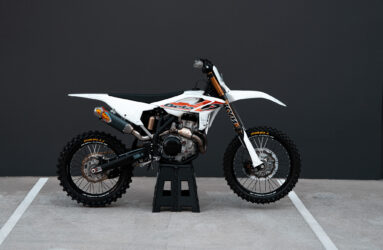
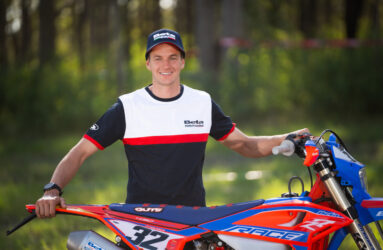


Be the first to comment...